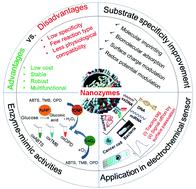Our official English website, www.x-mol.net, welcomes your
feedback! (Note: you will need to create a separate account there.)
Nanozyme-based electrochemical biosensors for disease biomarker detection.
Analyst ( IF 3.6 ) Pub Date : 2020-05-11 , DOI: 10.1039/d0an00558d Rabbee G Mahmudunnabi 1 , Fatema Zerin Farhana , Navid Kashaninejad , Shakhawat H Firoz , Yoon-Bo Shim , Muhammad J A Shiddiky
Analyst ( IF 3.6 ) Pub Date : 2020-05-11 , DOI: 10.1039/d0an00558d Rabbee G Mahmudunnabi 1 , Fatema Zerin Farhana , Navid Kashaninejad , Shakhawat H Firoz , Yoon-Bo Shim , Muhammad J A Shiddiky
Affiliation

|
In recent years, a new group of nanomaterials named nanozymes that exhibit enzyme-mimicking catalytic activity has emerged as a promising alternative to natural enzymes. Nanozymes can address some of the intrinsic limitations of natural enzymes such as high cost, low stability, difficulty in storage, and specific working conditions (i.e., narrow substrate, temperature and pH ranges). Thus, synthesis and applications of hybrid and stimuli-responsive advanced nanozymes could revolutionize the current practice in life sciences and biosensor applications. On the other hand, electrochemical biosensors have long been used as an efficient way for quantitative detection of analytes (biomarkers) of interest. As such, the use of nanozymes in electrochemical biosensors is particularly important to achieve low cost and stable biosensors for prognostics, diagnostics, and therapeutic monitoring of diseases. Herein, we summarize the recent advances in the synthesis and classification of common nanozymes and their application in electrochemical biosensor development. After briefly overviewing the applications of nanozymes in non-electrochemical-based biomolecular sensing systems, we thoroughly discuss the state-of-the-art advances in nanozyme-based electrochemical biosensors, including genosensors, immunosensors, cytosensors and aptasensors. The applications of nanozymes in microfluidic-based assays are also discussed separately. We also highlight the challenges of nanozyme-based electrochemical biosensors and provide some possible strategies to address these limitations. Finally, future perspectives on the development of nanozyme-based electrochemical biosensors for disease biomarker detection are presented. We envisage that standardization of nanozymes and their fabrication process may bring a paradigm shift in biomolecular sensing by fabricating highly specific, multi-enzyme mimicking nanozymes for highly sensitive, selective, and low-biofouling electrochemical biosensors.
中文翻译:

基于纳米酶的电化学生物传感器,用于疾病生物标志物检测。
近年来,出现了一组新的名为纳米酶的纳米材料,它们具有模仿酶的催化活性,已经有望替代天然酶。纳米酶可以解决天然酶的一些固有局限性,例如成本高,稳定性差,储存困难以及特定的工作条件(即,狭窄的底物,温度和pH范围)。因此,杂交和刺激响应的先进纳米酶的合成和应用可以彻底改变生命科学和生物传感器应用中的当前实践。另一方面,电化学生物传感器长期以来一直用作定量检测目标分析物(生物标记物)的有效方法。这样,在酶生物传感器中使用纳米酶对于实现用于疾病的预后,诊断和治疗监测的低成本和稳定的生物传感器特别重要。在这里,我们总结了常见的纳米酶的合成和分类及其在电化学生物传感器开发中的应用的最新进展。在简要概述了纳米酶在基于非电化学的生物分子传感系统中的应用之后,我们将彻底讨论基于纳米酶的电化学生物传感器的最新技术进展,包括基因传感器,免疫传感器,细胞传感器和适体传感器。纳米酶在基于微流体的测定中的应用也将单独讨论。我们还将重点介绍基于纳米酶的电化学生物传感器的挑战,并提供一些可能的策略来解决这些局限性。最后,提出了基于纳米酶的电化学生物传感器用于疾病生物标志物检测的发展前景。我们设想,通过为高度敏感,选择性和低生物污染的电化学生物传感器制造高特异性,多酶模拟纳米酶,纳米酶及其制备过程的标准化可能会带来生物分子传感领域的范式转变。
更新日期:2020-06-29
中文翻译:

基于纳米酶的电化学生物传感器,用于疾病生物标志物检测。
近年来,出现了一组新的名为纳米酶的纳米材料,它们具有模仿酶的催化活性,已经有望替代天然酶。纳米酶可以解决天然酶的一些固有局限性,例如成本高,稳定性差,储存困难以及特定的工作条件(即,狭窄的底物,温度和pH范围)。因此,杂交和刺激响应的先进纳米酶的合成和应用可以彻底改变生命科学和生物传感器应用中的当前实践。另一方面,电化学生物传感器长期以来一直用作定量检测目标分析物(生物标记物)的有效方法。这样,在酶生物传感器中使用纳米酶对于实现用于疾病的预后,诊断和治疗监测的低成本和稳定的生物传感器特别重要。在这里,我们总结了常见的纳米酶的合成和分类及其在电化学生物传感器开发中的应用的最新进展。在简要概述了纳米酶在基于非电化学的生物分子传感系统中的应用之后,我们将彻底讨论基于纳米酶的电化学生物传感器的最新技术进展,包括基因传感器,免疫传感器,细胞传感器和适体传感器。纳米酶在基于微流体的测定中的应用也将单独讨论。我们还将重点介绍基于纳米酶的电化学生物传感器的挑战,并提供一些可能的策略来解决这些局限性。最后,提出了基于纳米酶的电化学生物传感器用于疾病生物标志物检测的发展前景。我们设想,通过为高度敏感,选择性和低生物污染的电化学生物传感器制造高特异性,多酶模拟纳米酶,纳米酶及其制备过程的标准化可能会带来生物分子传感领域的范式转变。











































 京公网安备 11010802027423号
京公网安备 11010802027423号